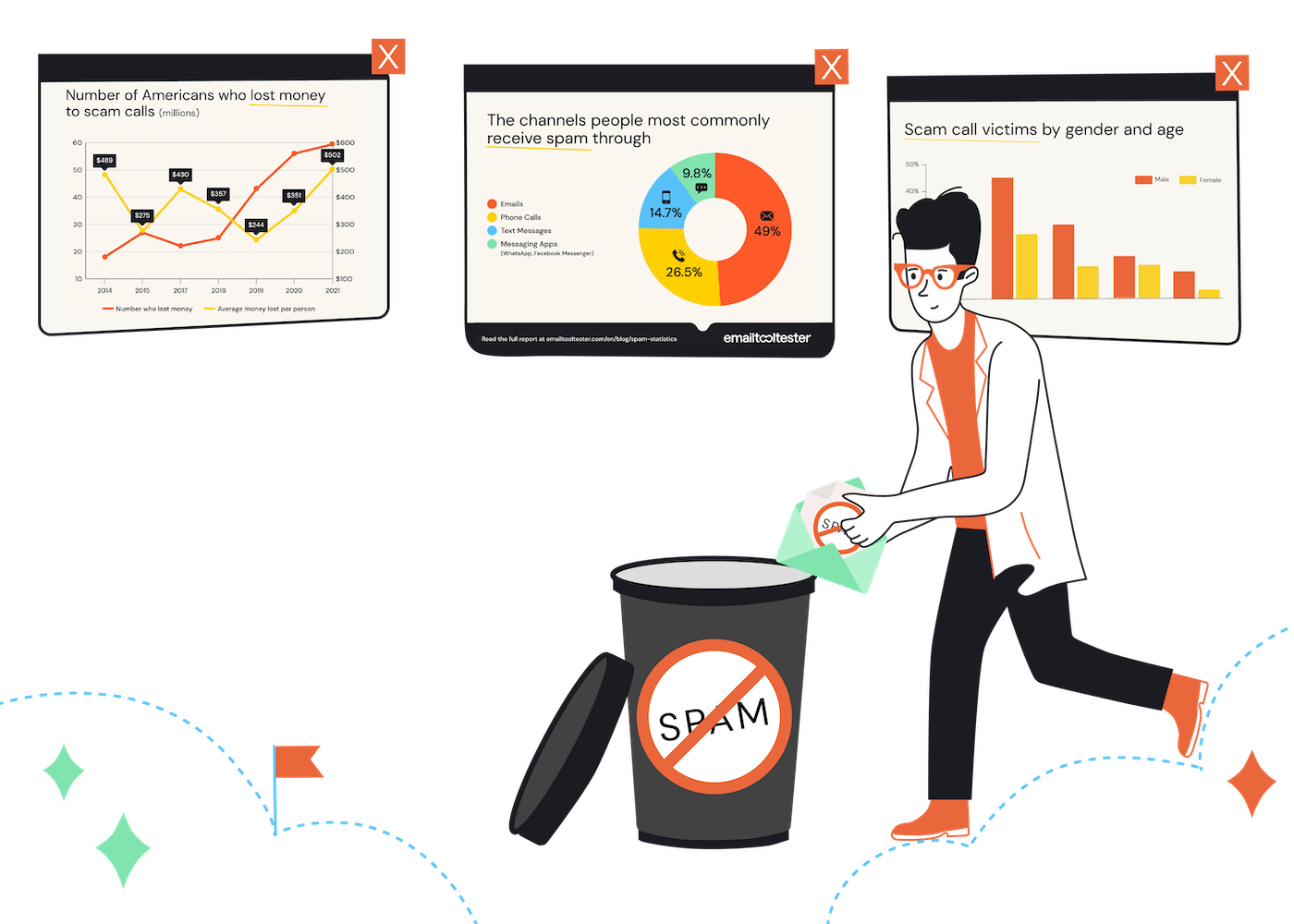Online spam is a problem we’re all familiar with, whether it’s emails, texts, or social media DMs, most of us receive some sort of spam every day. But just how big is the problem, and how much has spam exploded in recent years? Could AI have had an impact on the growing levels of online spam?
We’ve put together some of the most intriguing spam statistics for 2025, alongside data from our own survey to investigate where the most spam comes from and just how much money spammers can make.
Key statistics
- 160 billion spam emails are sent every day, with 46% of the 347 billion daily emails sent, considered spam (numbers recorded for 2023).
- The majority of people (96.8%) have received spam messages in some form.
- The U.S. sends the most spam emails, with 8 billion per day on average followed by China with 7.6 billion per day.
- The most common topic of spam emails is prizes and giveaways, followed by job opportunities, and banking.
- Over two-thirds (68.8%) of people who had received spam and/or phishing messages reported their mental health being impacted at least a little as a result.
- Financial institutions are most commonly targeted by business phishing attacks, with 27.7% of scam messages being received by companies in this sector.
- Delivery services were the most common subject of spam text messages in the U.S. in the first half of 2023, with over 1.1 billion scam texts relating to this topic.
- Men aged 65 and over receive the most spam calls with an average of 35.5 calls per month, while men aged 18-34 receive the fewest (14.2).
- The ten countries that send the most spam emails produce 2,184 metric tonnes of CO2 every day, or 797,160 over the course of one year from spam emails alone. In one day, that’s equivalent to 5.3 million miles driven in a conventional gas car, or 1.9 billion miles over the course of a year.
- Over three-quarters (77%) of people who have fallen victim to an AI phone scam have lost money to the scammers.
Number of spam emails is increasing (even as % decreases)
The total number of emails sent every day increases each year. Between 2017 and 2022 that daily total grew from 269 to 333.2 billion, which means that over 64 billion more emails were sent every day last year than 5 years previously!
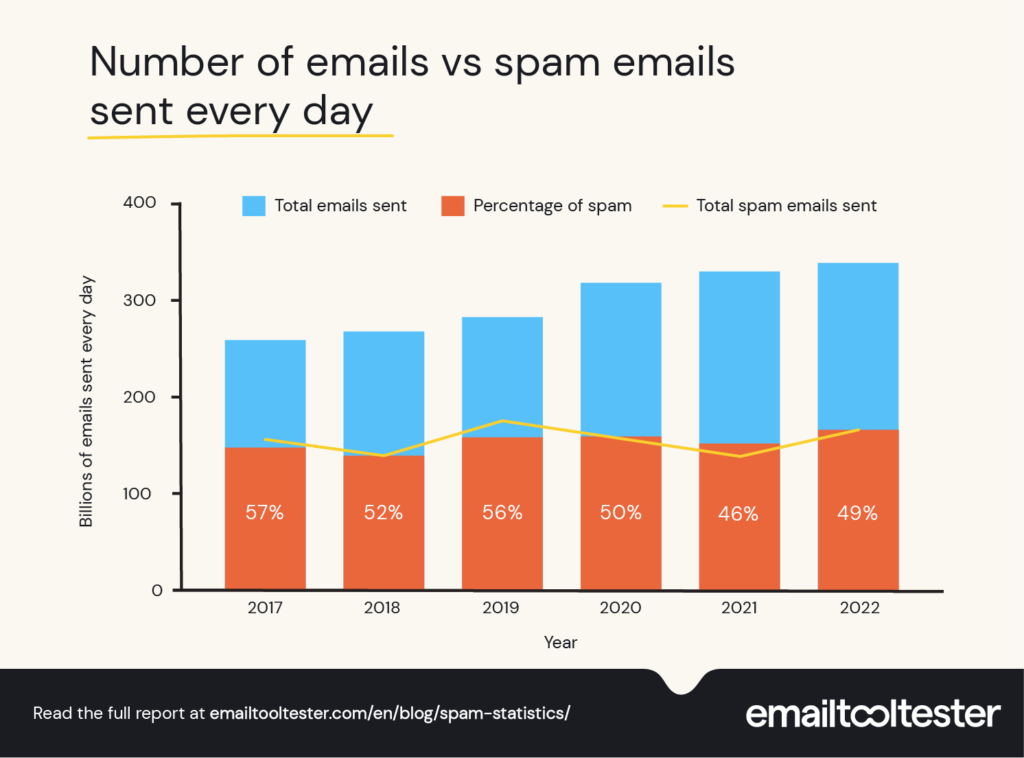
How many spam emails are sent per day?
In 2023, over 160 billion spam emails were sent every day! (Source 1 and Source 2)
The percentage of total email traffic that is identified as spam, has consistently decreased (from 56.63% in 2017 to 45.6% in 2023). Security experts put this down to action against botnets (networks of hijacked computers that have historically been used to send spam).
Does this mean we’re all receiving less spam emails?
No! Unfortunately, the increase in the total number of emails sent, makes up for the decrease in the proportion of emails that are identified as spam. So in fact, the number of spam emails has slightly increased over the same period.
Most people have received scam or phishing-related messages
We carried out a survey which found that the vast majority (96.8%) of people have received spam messages relating to scams through emails, text messages, phone calls, or other types of messages.
The most common channel people say they receive spam through is email, with almost half (49%) saying they receive spam via emails most often. This was followed by phone calls (26.5%), then text messages (14.7%), and messaging apps like WhatsApp and Facebook Messenger came lowest with 9.8%.
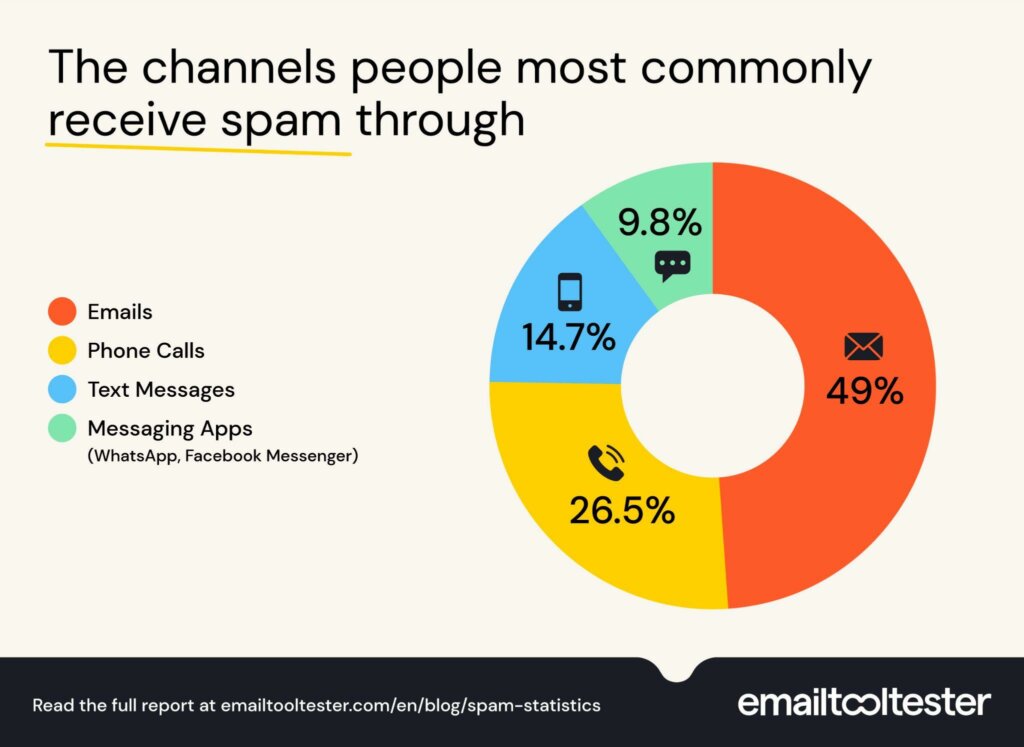
Over half of people have lost money to online or telephone scams
Of the 96.8% of respondents who had received messages or calls involving scams, 57.1% of this group said that they had lost money as a result of the scam. The most common amount people said they had lost in total because of these scams was $100-$249, however, 2.9% said they had lost over $1,000.
Countries with the worst spam issues
Some countries have worse spam issues than others, often due to weak or non-existent anti-spam laws that allow spam operations to be carried out more easily.
China has the most spam-emitting IP addresses
The latest figures show that China has the most spam-emitting IP addresses, totaling 771,021. This is followed by the U.S. with 677,067, and then Brazil with 253,248.
| Country | Number of current live spam issues |
|---|---|
| China | 771,021 |
| United States of America | 677,067 |
| Brazil | 253,248 |
| United Kingdom | 139,085 |
| India | 88,042 |
| Netherlands | 83,587 |
| Vietnam | 79,848 |
| Italy | 79,326 |
| Germany | 56,728 |
| Morocco | 52,663 |
Source: Spam Haus
The U.S. sends the most spam emails per day
There are 8 billion spam emails sent in the United States every day, making this the country sending the most spam emails in total. The country with the second-highest number of spam emails per day is China with 7.6 billion, followed by both Germany and Russia, with 7.3 billion.
| Country | Number of spam emails sent per day (billions) |
|---|---|
| United States | 8 |
| China | 7.6 |
| Germany | 7.3 |
| Russia | 7.3 |
| Singapore | 7.2 |
| Japan | 7.2 |
| France | 7.2 |
| Netherlands | 7.1 |
| Ukraine | 7 |
| Canada | 6.9 |
Source: Statistica
The environmental impact of spam emails
When it comes to sending and receiving emails, the environmental impact is something that can be overlooked. Data from Carbon Literacy shows that a short email sent and received on a phone can produce 0.2g of carbon emissions, while a spam email picked up by filters can produce 0.03g of carbon emissions.
We used this information to determine just how much carbon was being produced by spam emails sent from the countries that send the most spam. The 8 billion spam emails sent from the U.S. each day will generate 240 metric tonnes of CO2 emissions. Over a year this would add up to a total of 87,600 metric tonnes of CO2.
For the top ten countries combined, spam emails produce 2,184 metric tonnes of CO2 every day, or 797,160 over the course of one year. In one day that’s equivalent to 5.3 million miles driven in a conventional gas car, or 1.9 billion miles driven over a year.
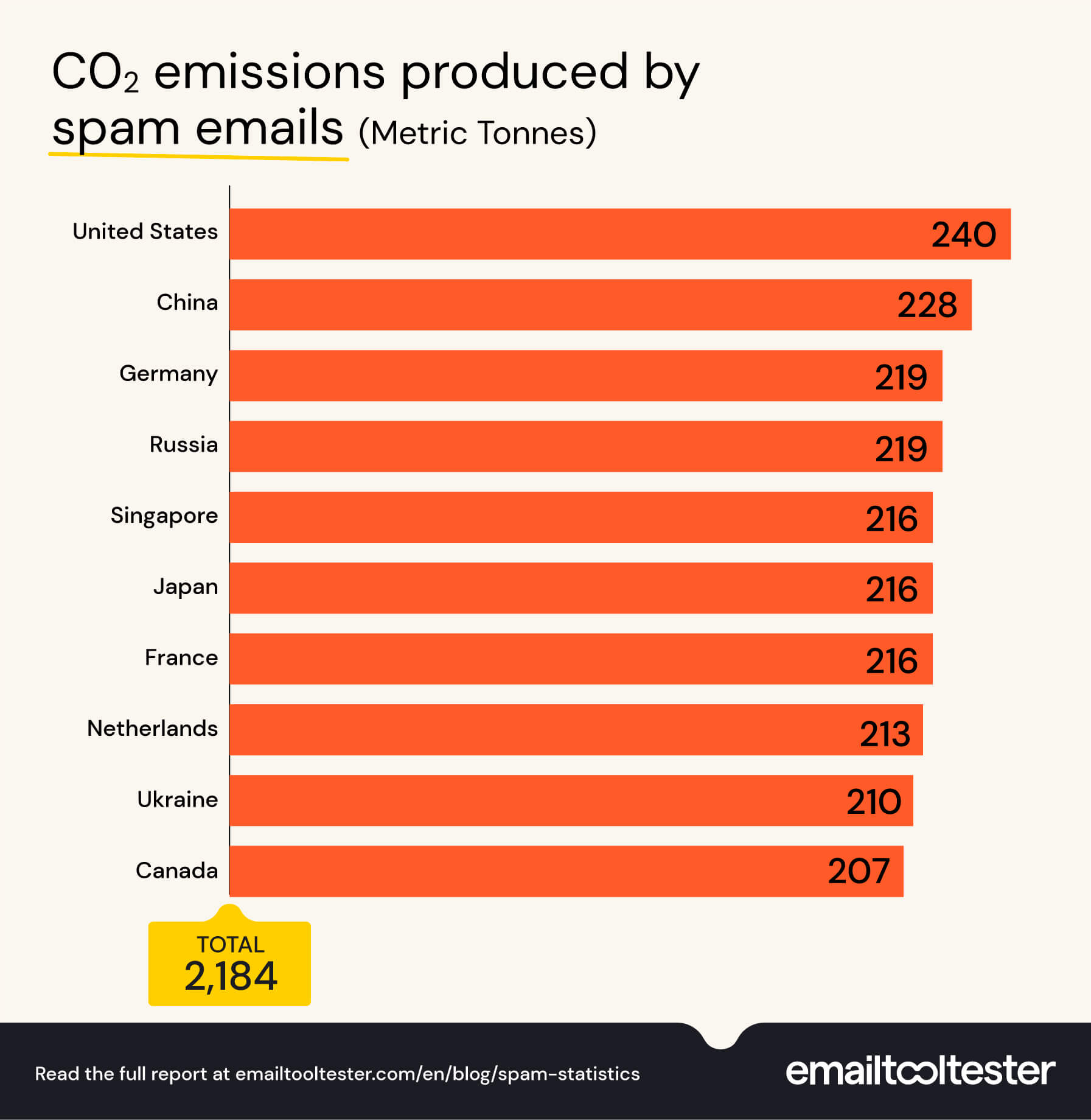
The most common topics of spam emails
Spam emails can contain a wealth of different topics from scammers posing as your bank to fake prizes telling you how to claim your ‘jackpot’. We asked our survey respondents which themes they see most commonly in the spam emails they receive.
The topic most commonly seen in spam emails is prizes and giveaways, with 36.7% of people saying this is one of the top themes they see. This was closely followed by emails relating to job opportunities (36.3%), and banking-related scams came in third at 34.6%.
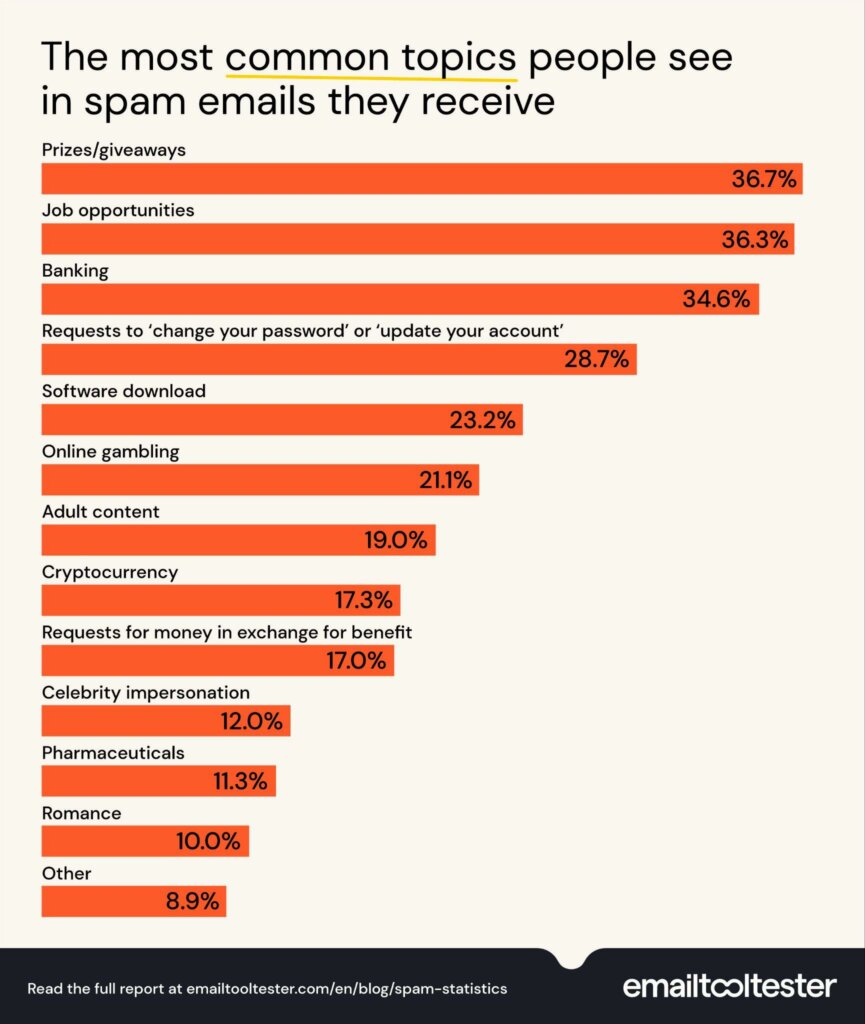
*Respondents were able to choose up to three options.
Spam text statistics
Robokiller estimates that Americans received a total of 78 billion automated spam texts throughout the first half of 2023, with most texts being received in January and May (14 billion each). In total, this is a $4 billion increase year-over-year compared to the same period in 2022.
| Spam texts per month USA | |
|---|---|
| Month | Estimated number of scam texts |
| January 2023 | 14,000,000,000 |
| February 2023 | 11,000,000,000 |
| March 2023 | 12,000,000,000 |
| April 2023 | 13,000,000,000 |
| May 2023 | 14,000,000,000 |
| June 2023 | 13,500,000,000 |
Delivery services are the most common topic of spam texts
There were over 1.1 billion scam texts relating to delivery services sent in the U.S. in the first half of 2023, making this the most common topic used in these kinds of texts. This was followed by bank-related content with 365 million texts and travel-related content with 179 million texts.
| Estimated top robotext categories 2023 | |
|---|---|
| Delivery | 1,129,510,869 |
| Bank scams | 363,928,213 |
| Travel | 179,443,012 |
| COVID-19 | 151,297,143 |
| Apple + hardware | 141,134,560 |
Losses to text scams
Scammers using SMS scams stole an estimated $13 billion between January and June 2023. These scams typically impersonate legitimate businesses, like delivery companies or banks, and trick people into clicking links or sharing personal information.
Spam call statistics
Spam calls are the most common type of computer-automated phone calls (or robocalls), with 155 million spam robocalls made in 2023. (Source: Hiya)
The number of people in the U.S. who lost money due to scam calls more than tripled between 2014 and 2021.
People lose $452 to scam callers on average
The latest figures from TrueCaller show that a total of $25.4 billion was lost to scam callers by 56.2 million people in a one-year period, meaning victims lost $452 on average. The number of people losing money to scam calls has increased dramatically compared to 2014 when 18 million people lost a total of $8.6 billion.
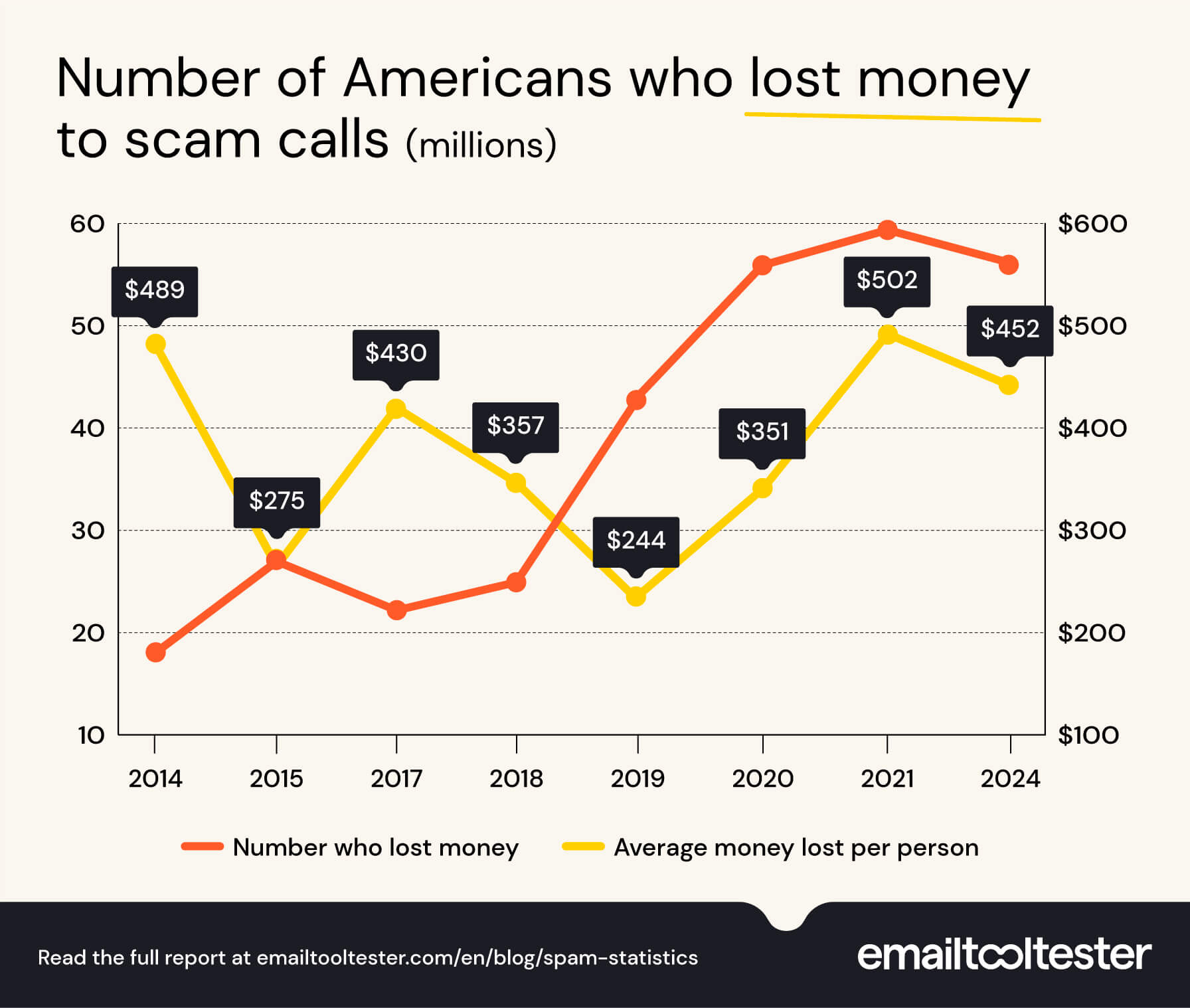
| Year | Number of Americans who lost money to scam calls (millions) | Total money lost (billion USD) | Average money lost |
|---|---|---|---|
| 2014 | 18 | $8.60 | $489 |
| 2015 | 27 | $7.40 | $275 |
| 2017 | 22.1 | $9.50 | $430 |
| 2018 | 24.9 | $8.90 | $357 |
| 2019 | 43 | $10.50 | $244 |
| 2020 | 56 | $19.70 | $351 |
| 2021 | 59.4 | $29.80 | $502 |
| 2024 | 56.2 | $25.40 | $452 |
Victims of scam calls
In total, women receive the most scam calls in age groups between 18 and 54, but men aged over 55 receive more scam calls than women in this age group. Men aged 65 and over receive the most scam calls at an average of 35.5 per month, though this is only slightly more than women over 65 receive (35.4).
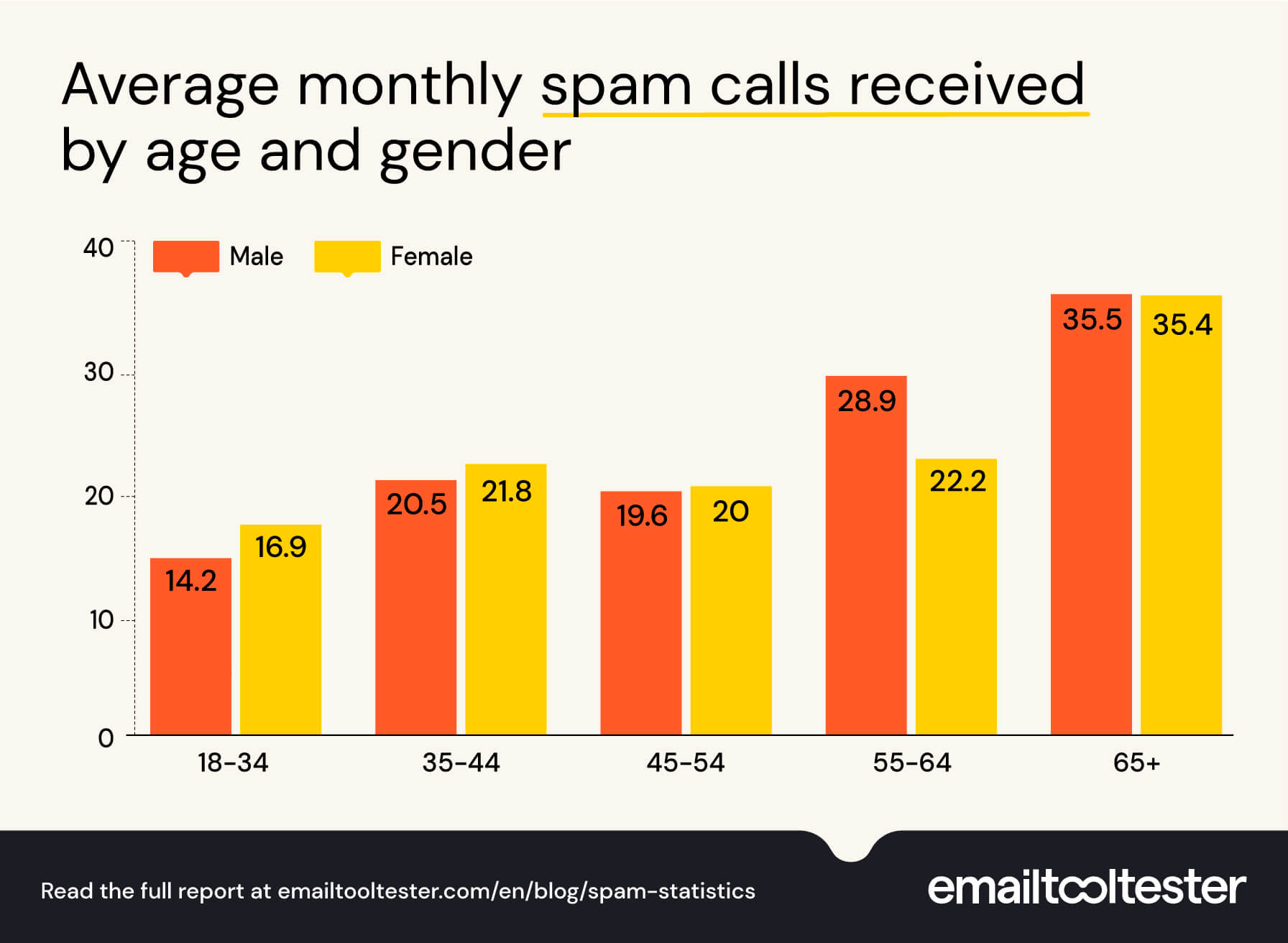
Hispanic and Black Americans are twice as likely to lose money to phone scams as White Americans. Almost half (47%) of Black Americans and 36% of Hispanic Americans say they have lost money to phone scams at least once, compared to 25% of White Americans.
The category of spam calls and texts also varies by ethnicity, with White people receiving more fraudulent communications about deliveries, vehicles and politics, while Hispanic Americans received more spam communications about student loans. (Source: TrueCaller)
Some countries receive more spam calls than others
One study into telephone spam found that the scale of spam calls varies greatly from country to country. In this context, spam is defined as unwanted calls including fraud and nuisance calls.
Chile has the highest rate of spam calls, with 56.9% of phone calls nationwide being unwanted, and 8.9% (or 15.6 million) of all calls being classed as fraud. This is followed by Indonesia where 56.4% of all calls were spam, with 1.4% being fraud.
Other countries with a high spam call rate include Argentina (56%), Hong Kong (54%), and Brazil (46.4%). The U.S. ranks 16th on the list with 25.3% of all calls being classed as spam.
| Rank | Country | Spam Calls Rate | Fraud Call Rates |
|---|---|---|---|
| 1 | Chile | 56.9% | 8.9% |
| 2 | Indonesia | 56.4% | 1.4% |
| 3 | Argentina | 56.0% | 31.0% |
| 4 | Hong Kong | 54.0% | 12.0% |
| 5 | Brazil | 46.4% | 9.4% |
| 6 | Spain | 44.9% | 5.9% |
| 7 | Mexico | 43.0% | 17.0% |
| 8 | France | 42.5% | 3.5% |
| 9 | Italy | 40.0% | – |
| 10 | Philippines | 29.4% | 8.4% |
| 11 | Australia | 28.3% | 7.3% |
| 12 | Poland | 27.4% | 5.4% |
| 13 | Finland | 27.4% | 4.4% |
| 14 | United Kingdom | 27.3% | 9.3% |
| 15 | Sweden | 26.8% | 5.8% |
| 16 | USA | 25.3% | 1.3% |
| 17 | Germany | 21.6% | – |
| 18 | Canada | 21.3% | 6.3% |
| 19 | Portugal | 21.0% | 1.0% |
| 20 | Singapore | 20.2% | 8.2% |
| 21 | Belgium | 19.2% | 1.2% |
| 22 | Switzerland | 19.0% | 1.0% |
| 23 | Malaysia | 16.9% | 4.9% |
| 24 | Peru | 16.6% | 0.6% |
| 25 | Puerto Rico | 15.7% | 5.7% |
| 26 | Denmark | 15.7% | 1.7% |
| 27 | Turkey | 15.3% | 8.4% |
| 28 | Norway | 15.3% | 2.3% |
| 29 | Netherlands | 13.3% | 2.3% |
| 30 | Czech Republic | 12.8% | 0.8% |
| 31 | India | 12.5% | 5.8% |
| 32 | Greece | 12.3% | 1.3% |
| 33 | Slovakia | 10.4% | 1.0% |
| 34 | Thailand | 10.3% | 1.5% |
| 35 | Israel | 9.0% | 1.2% |
| 36 | Austria | 9.0% | 1.4% |
| 37 | Hungary | 8.4% | 2.5% |
| 38 | New Zealand | 7.9% | 1.1% |
| 39 | Ireland | 4.4% | 1.0% |
Source: Hiya
Spam calls per person
The number of spam calls each person receives also varies by country. People in Brazil currently receive the highest number with an average of 25 nuisance or fraud calls each month. Hong Kong comes in second with 20, followed by Chile with 18 spam calls per person per month on average.
The countries where people receive the fewest spam calls are the Netherlands, Hungary, New Zealand, and Ireland with only one spam call per person per month on average.
| Rank | Country | Spam Calls Per Person Per Month |
|---|---|---|
| 1 | Brazil | 25 |
| 2 | Hong Kong | 20 |
| 3 | Chile | 18 |
| 4 | Mexico | 16 |
| 5 | USA | 12 |
| 6 | Spain | 10 |
| 6 | Italy | 10 |
| 6 | India | 10 |
| 9 | France | 9 |
| 10 | Puerto Rico | 8 |
| 11 | Indonesia | 7 |
| 11 | Argentina | 7 |
| 11 | Philippines | 7 |
| 14 | Poland | 6 |
| 14 | Peru | 6 |
| 16 | Australia | 5 |
| 17 | Finland | 4 |
| 17 | United Kingdom | 4 |
| 17 | Sweden | 4 |
| 17 | Portugal | 4 |
| 17 | Turkey | 4 |
| 17 | Israel | 4 |
| 23 | Canada | 3 |
| 23 | Malaysia | 3 |
| 23 | Greece | 3 |
| 26 | Germany | 2 |
| 26 | Singapore | 2 |
| 26 | Belgium | 2 |
| 26 | Switzerland | 2 |
| 26 | Denmark | 2 |
| 26 | Norway | 2 |
| 26 | Czech Republic | 2 |
| 26 | Slovakia | 2 |
| 26 | Thailand | 2 |
| 26 | Austria | 2 |
| 36 | Netherlands | 1 |
| 36 | Hungary | 1 |
| 36 | New Zealand | 1 |
| 36 | Ireland | 1 |
Source: Hiya
The success rate of online spam
A 2022 report from IBM found that the click rate of an average targeted phishing attack was 17.8%. However, when phishing campaigns included phone calls (voice phishing), they were clicked by 53.2% of recipients, making them three times more effective.
How much money do spammers make?
One example from researchers at UC San Diego found that online spammers made around $7,000 per day on average, this amounts to approximately $2.5 million per year. However, this figure can vary widely depending on the scam operating, with some making very little and some making much more. (Source: UC San Diego)
The industries most targeted by phishing scams
While some phishing scams are targeted at individuals, many of these operations target businesses in an effort to obtain sensitive information or install malware on company computers. Since email is the most commonly used workplace communication tool, it makes sense that these phishing scams are predominantly in the form of emails.
Financial institutions, including banks, are the most common targets for business phishing attacks, with 27.7% of phishing emails or messages being sent to these companies. This is followed by SaaS and webmail companies at 17.7%, and social media companies at 10.4%.
| Industry | Share of phishing messages received |
|---|---|
| Financial institution | 27.7% |
| SaaS/Webmail | 17.7% |
| Social media | 10.4% |
| Logistics/Shipping | 9% |
| Payment | 6% |
| E-commerce/Retail | 5.6% |
| Telecom | 3.1% |
| Cryptocurrency | 2.3% |
| Other | 18.2% |
AI and spam
With the use of AI tools on the rise, scammers are also making use of this technology to catch people online and over the phone.
AI voice cloning scams
A survey by McAfee found that 25% of adults had experienced a scam that used an AI voice. 10% of respondents said that they had personally been targeted, and 15% said it had happened to someone they knew. Of those who had fallen victim to an AI voice scam, 77% had lost money to the scammers.
Many of these scams include AI voice cloning, where the voice of someone you know is cloned and used to gain your trust in order to convince you to share your personal details or send money. This could be the voice of a friend or family member in distress, or a voice purporting to be from your bank or a government organization.
In the UK, Starling Bank reported that 28% of adults say they had been targeted by an AI voice cloning scam at least once in the past year, but 46% of people surveyed said they had not heard of these scams.
In our survey, 81.1% of people said they were aware that AI software is being used to imitate people’s voices in telephone scams, and a similar number (80.8%) said they were concerned about it. However, 63.1% said they were confident they could tell the difference between an AI voice and a human voice.
An increase in spam since ChatGPT’s release
The release of the AI chatbot, ChatGPT, in 2022 provided users with a handy tool that could answer questions, generate content, write emails, and carry out a whole host of other tasks. But the launch of ChatGPT also gave scammers a way to refine their attacks and increase their frequency.
Research carried out by Darktrace found a 135% increase in ‘novel social engineering’ attacks in early 2023 following the widespread rollout of ChatGPT. These attacks are designed to create a sense of urgency, fear, or curiosity which persuades victims to take action.
Almost three-quarters (73%) of people said that they were concerned that hackers could use generative AI tools like ChatGPT to create spam emails that were almost impossible to distinguish from genuine emails. A Tooltester study found that 63.5% of people can’t identify content made purely by the ChatGPT 4.0 model.
Using AI to protect people from spam
Email providers and cybersecurity companies often use AI to detect online spam and filter it into junk folders or prevent it from accessing a victim’s computer. In fact, Google says its AI-powered spam filtering technology blocks more than 99.9% of spam, phishing, and malware from reaching users’ Gmail inboxes. Google also states that their AI-enhanced filters block almost 10 million spam emails every minute.
People’s thoughts on spam and how it affects them
During our survey, we also asked people their opinions on different topics relating to online spam, and how it has affected them.
Most people (86.5%) said they thought the number of scam messages and emails they receive had increased in the past year. Concerningly, over two-thirds (68.8%) said their mental health had been impacted by an online scam, with 41% of people saying it had impacted their mental health considerably and 27.8% saying it had been affected a little.
Around four in five (79.6%) people said that they knew someone else who had been the victim of online scams or fraud, with 28.8% saying they knew of more than one person who had been affected.
Cold emails = spam?
In another survey we ran on the topic of cold emails, we found that around half (50.9%) said they don’t engage with cold emails at all. 13.7% of people say they delete them straight away, and 10.3% say they mark them as junk.
Catching spam
The overwhelming majority of people (95.9%) think that they’re able to spot spam or fraudulent messages, with 56.6% saying they can pick them out easily. However, 39.3% said they can generally spot them but not always. Almost three-quarters (73.3%) also think that spam filters do a good job of blocking spam emails from entering inboxes.
Check out our study of political emails, which found that Republican emails are more likely than Democrat emails to go to spam.
Survey Methodology
We carried out a survey of 1,044 people in the U.S. between 02/10/23 and 09/10/23 to ask about their experiences with online spam and scam-related communications.
The breakdown of the survey respondents was as follows:
- Male: 54.2%
- Female: 44.9%
- Non-binary: 0.4%
- Preferred not to say: 0.5%
- 18-24: 4.5%
- 25-34: 38.1%
- 35-44: 38.3%
- 45-54: 10.9%
- 55-64: 5.4%
- Over 65: 2.7%
We keep our content up to date
16 Oct 2024 - general update
23 Aug 2024 - Updated number for total number of spam emails
Our Methodology
This article has been written and researched following our EmailTooltester methodology.
Our Methodology